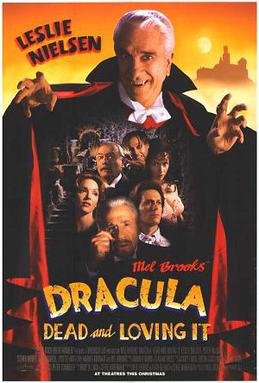
Dracula: Dead and Loving It is a 1995 comedy horror film directed by Mel Brooks and starring Leslie Nielsen. It is a spoof of Bram Stoker's novel Dracula and of some of the story's well-known adaptations.
Count Orlok, commonly but erroneously known as Nosferatu, is a fictional character who appears in the silent film Nosferatu, eine Symphonie des Grauens (1922) and in its remake Nosferatu (2024), which is based on Bram Stoker's character Count Dracula.
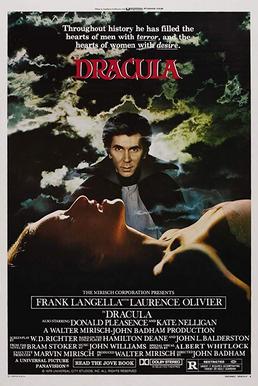
Dracula is a 1979 gothic horror film directed by John Badham. The film starred Frank Langella in the title role as well as Laurence Olivier, Donald Pleasence and Kate Nelligan.
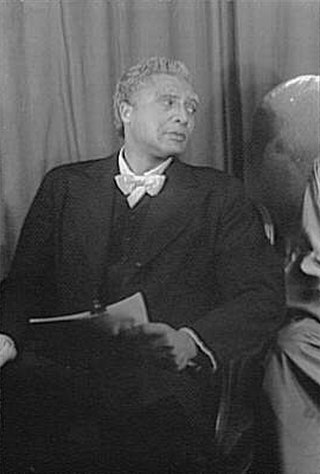
William Horace Marshall was an American actor, director and opera singer. He played the title role in the 1972 blaxploitation classic Blacula and its sequel Scream Blacula Scream (1973), and appeared as the King of Cartoons on the 1980s television show Pee-wee's Playhouse and as Dr. Richard Daystrom on the Star Trek television series. He was 6‘5” tall and was known for his bass voice.

Dracula 2000 is a 2000 American gothic horror film co-written and directed by Patrick Lussier and produced by Joel Soisson and stars Gerard Butler, Christopher Plummer, Jonny Lee Miller, Justine Waddell, Omar Epps, Colleen Fitzpatrick, Jeri Ryan and Jennifer Esposito. The plot follows Dracula, who arrives in New Orleans, Louisiana in the 21st century and seeks out Mary Heller, the daughter of Abraham Van Helsing.

Vampire films have been a staple in world cinema since the era of silent films, so much so that the depiction of vampires in popular culture is strongly based upon their depiction in films throughout the years. The most popular cinematic adaptation of vampire fiction has been from Bram Stoker's 1897 novel Dracula, with over 170 versions to date. Running a distant second are adaptations of the 1872 novel Carmilla by Sheridan Le Fanu. By 2005, the Dracula character had been the subject of more films than any other fictional character except Sherlock Holmes.
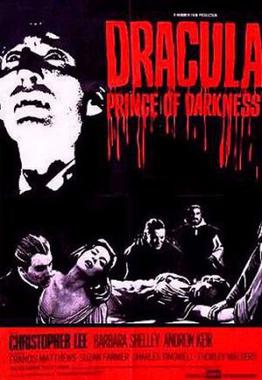
Dracula: Prince of Darkness is a 1966 British gothic supernatural horror film directed by Terence Fisher. The film was produced by Hammer Film Productions, and is the third entry in Hammer's Dracula series, as well as the second to feature Christopher Lee as Count Dracula, the titular vampire. It also stars Andrew Keir, Francis Matthews, and Barbara Shelley.

Scars of Dracula is a 1970 British horror film directed by Roy Ward Baker for Hammer Films. It stars Christopher Lee as Count Dracula, along with Dennis Waterman, Jenny Hanley, Patrick Troughton, and Michael Gwynn.
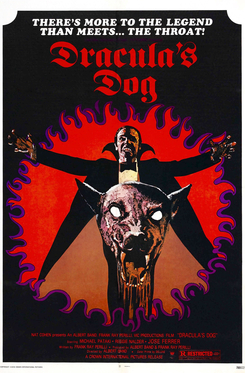
Dracula's Dog, also known as Zoltan... Hound of Dracula, is a 1977 American supernatural horror film directed by Albert Band and starring Michael Pataki and José Ferrer. Its plot revolves around a Doberman Pinscher who is turned into a vampire by a member of the Dracula family, who is also a vampire.

Taste the Blood of Dracula is a 1970 British supernatural horror film produced by Hammer Film Productions. Directed by Peter Sasdy from a script by Anthony Hinds, it is the fifth installment in Hammer's Dracula series, and the fourth to star Christopher Lee as Count Dracula, the titular vampire. The film also features Geoffrey Keen and Gwen Watford.
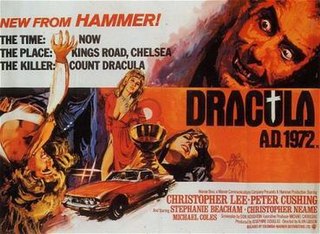
Dracula A.D. 1972 is a 1972 British horror film, directed by Alan Gibson and produced by Hammer Film Productions. It was written by Don Houghton and stars Christopher Lee, Peter Cushing and Stephanie Beacham. Unlike earlier films in Hammer's Dracula series, Dracula A.D. 1972 had a contemporary setting in an attempt to update the Dracula story for modern audiences. Dracula is brought back to life in modern London and preys on a group of young partygoers that includes the descendant of his nemesis, Van Helsing.
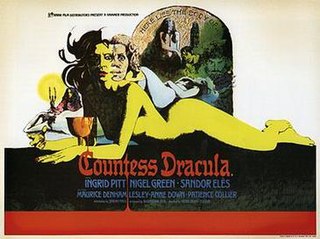
Countess Dracula is a 1971 British Hammer horror film directed by Peter Sasdy and starring Ingrid Pitt, Nigel Green and Lesley-Anne Down. It was produced by Alexander Paal.

Vampira is a 1974 British comedy horror film directed by Clive Donner, and starring David Niven and Teresa Graves. This spoof of the vampire genre was re-titled Old Dracula for release in the United States, in an attempt to ride the success of Young Frankenstein.

Scream Blacula Scream is a 1973 American blaxploitation vampire horror film. It is a sequel to the 1972 film Blacula. The film was produced by American International Pictures (AIP) and Power Productions. This was the acting debut of Richard Lawson.

Blackenstein, also known as Black Frankenstein on its theatrical release poster and whose actual on-screen title is Blackenstein the Black Frankenstein, is a 1973 American blaxploitation horror film directed by William A. Levey, and starring John Hart, Ivory Stone, Andrea King, Roosevelt Jackson, Joe De Sue, Nick Bolin and Liz Renay. It is loosely based on Mary Shelley's 1818 novel Frankenstein; or, The Modern Prometheus. Released on August 3, 1973, it was made in an attempt to cash in on the success of Blacula; released the previous year by American International Pictures. However, Blackenstein fared poorly in comparison to its predecessor, with most reviews agreeing that the film was "a totally inept mixture of the worst horror and blaxploitation films".
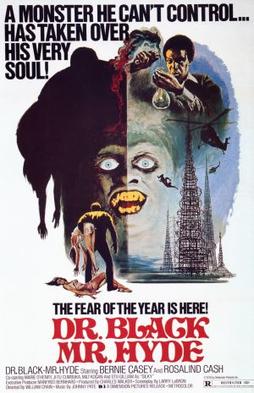
Dr. Black, Mr. Hyde is a 1976 blaxploitation horror film loosely inspired by the 1886 novella Strange Case of Dr. Jekyll and Mr. Hyde by Robert Louis Stevenson. The film stars Bernie Casey and Rosalind Cash, and was directed by William Crain. Along with Crain, and it was written by Larry LeBron and Lawrence Woolner with cinematography by Tak Fujimoto. It was filmed primarily in Los Angeles, at locations such as the Watts Towers.

Sugar Hill is a 1974 American horror blaxploitation zombie film, directed by Paul Maslansky and starring Marki Bey as the title character who uses voodoo to get revenge on the people responsible for her boyfriend's death. It was released by American International Pictures. According to the film, the zombies are the preserved bodies of slaves brought to the United States from Guinea. AIP had previously combined the horror and blaxploitation genres with Blacula (1972) and its sequel Scream Blacula Scream (1973).
Deafula is a 1975 American horror film done completely in American Sign Language. A voice over is provided for those who do not understand sign language. The film starred Peter Wechsberg, who also serves as director and writer, under the pseudonym Peter Wolf. It was the first American Sign Language feature film ever made. The film tells the story of a young man who cannot control his urge to kill people for their blood, and the police investigation searching for the murderer.

Blaxploitation is an ethnic subgenre of the exploitation film that emerged in the United States during the early 1970s, after the demand of the Black Panthers for black artists to reclaim the power and rights to their image from the UCLA, and the new rating system within Hollywood allowed up and coming black film makers and actors to create black films for black audiences. The term, a portmanteau of the words "black" and "exploitation", was coined in August 1972 by Junius Griffin, the president of the Beverly Hills–Hollywood NAACP branch. He claimed the genre was "proliferating offenses" to the black community in its perpetuation of stereotypes often involved in crime. After the race films of the 1940s and 1960s, the genre emerged as one of the first in which black characters and communities were protagonists, rather than sidekicks, supportive characters, or victims of brutality. The genre's inception coincides with the rethinking of race relations in the 1970s.
Blaxploitation horror films are a genre of horror films involving mostly black actors. In 1972 director William Crain did the first blaxploitation horror film, Blacula.

















